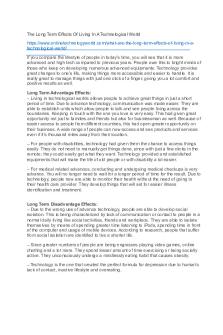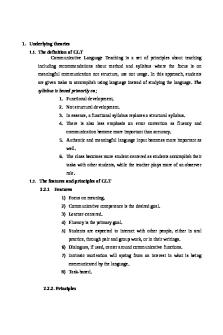Communicative Language Teaching PDF

| Title | Communicative Language Teaching |
|---|---|
| Author | الشارع الانكَليزي - English Way |
| Course | Linguistics |
| Institution | University of Thi-Qar |
| Pages | 3 |
| File Size | 231.8 KB |
| File Type | |
| Total Downloads | 82 |
| Total Views | 150 |
Summary
Download Communicative Language Teaching PDF
Description
Summarized by Zahra Al-Hashimy Book: Techniques & Principles in Language Teaching Author: Diane Larsen-Freeman, Marti Anderson Edition: 3rd
Communicative Language Teaching 1. What is the aim of Communicative Language Teaching? CLT aims broadly to make communicative competence the goal of language teaching. Communication is a process; knowledge of the forms of language is insufficient.
Communicative competence: knowing when and how to say what to whom. Being communicatively competent in the target language means being able to communicate appropriately with others.
Linguistic competence: mastery of the linguistic structures of the target language.
2. According to Morrow activities that are truly communicative have three features in common, what are they? Information gap, choice, and feedback. 1.
An information gap exists when one person in an exchange knows something the other person does not.
2.
In communication, the speaker has a choice of what she will say and how she will say it.
3.
True communication is purposeful. A speaker can thus evaluate whether or not her purpose has been achieved based upon the information (feedback) she receives from her listener.
1. What are the goals of teachers who use Communicative Language Teaching (CLT)? The goal is to
enable students to communicate in the target language.
To do this, students …
need knowledge of the linguistic forms, meanings, and functions. need to know that many different forms can be used to perform a function and also that a single form can often serve a variety of functions.
must be able to choose from among these the most appropriate form, given the social context and the roles of the interlocutors.
must be able to manage the process of negotiating meaning with their interlocutors. 2. What is the role of the teacher? What is the role of the students?
facilitates communication, an advisor, a “co-communicator” Students communicators
Teacher
The teacher facilitates communication in the classroom. In this role, one of his major responsibilities is to establish situations likely to promote communication.
During the activities he acts as an advisor, answering students’ questions and monitoring their performance. He might make a note of their errors to be worked on at a later time during more accuracy-based activities. At other times he might be a “co-communicator” engaging in the communicative activity along with students.
Students are communicators. They are actively engaged in negotiating meaning, in trying to make themselves understood.
3. What are some characteristics of the teaching/learning process?
The most obvious characteristic of CLT is that almost everything that is done is done with a communicative intent. Students use the language a great deal through communicative activities such as games, role-plays, and problem-solving tasks.
Another characteristic of CLT is the use of authentic materials.
Finally, we noted that activities in CLT are often carried out by students in small groups.
4. What is the nature of student–teacher interaction? What is the nature of student–student interaction?
The teacher may present some part of the lesson. At other times, he is the facilitator of the activities, but he does not always himself interact with the students. Sometimes he is a co-communicator, but more often he establishes situations that prompt communication between and among the students.
Students interact a great deal with one another. They do this in various configurations: pairs, triads, small groups, and whole group.
5. How are the feelings of the students dealt with? One of the basic assumptions of CLT is that by learning to communicate students will be more motivated to study another language since they will feel they are learning to do something useful. Also, teachers give students an opportunity to express their individuality by having them share their ideas and opinions on a regular basis. Finally, student security is enhanced by the many opportunities for cooperative interactions with their fellow students and the teacher.
6. How is the language viewed? How is culture viewed?
Language is for communication.
Linguistic competence, the knowledge of forms and their meanings, is only one part of communicative competence. Another aspect of communicative competence is knowledge of the functions that language is used for.
Culture is the everyday lifestyle of people who use the language.
There are certain aspects of it that are especially important to communication—the use of nonverbal behavior, for example, which might receive greater attention in CLT.
7. What areas of language are emphasized? What language skills are emphasized?
Language functions might be emphasized over forms. Typically, a functional syllabus is used.
Students work with language at the discourse or suprasentential level. They learn about cohesion and coherence.
Students work on all four skills from the beginning. Just as oral communication is seen to take place through negotiation between speaker and listener, so too is meaning thought to be derived from the written word through an interaction between the reader and the writer.
8. What is the role of the students’ native language? Judicious use of the students ’ native language is permitted in CLT. The target language should be used not only during communicative activities, but also for
explaining the
activities to the students or in assigning homework.
9. How is evaluation accomplished? A teacher evaluates not only his students’
accuracy, but also their fluency.
A teacher can evaluate his students ’ performance informally in his role as advisor or co -communicator. For more formal evaluation, a teacher is likely to use an integrative test which has a real communicative function.
10. How does the teacher respond to student errors? Errors of form are tolerated during fluency-based activities and are seen as a natural outcome of the development of communication skills. The teacher may note the errors during fluency activities and return to them later with an accuracy-based activity....
Similar Free PDFs

Communicative Language Teaching
- 3 Pages

Task-based language teaching
- 238 Pages

English Language Teaching
- 9 Pages

English Language Teaching
- 7 Pages

Communicative
- 20 Pages

Methodology in Language Teaching
- 433 Pages

English Language Teaching
- 16 Pages

LANGUAGE TEACHING MEDIA
- 1 Pages
Popular Institutions
- Tinajero National High School - Annex
- Politeknik Caltex Riau
- Yokohama City University
- SGT University
- University of Al-Qadisiyah
- Divine Word College of Vigan
- Techniek College Rotterdam
- Universidade de Santiago
- Universiti Teknologi MARA Cawangan Johor Kampus Pasir Gudang
- Poltekkes Kemenkes Yogyakarta
- Baguio City National High School
- Colegio san marcos
- preparatoria uno
- Centro de Bachillerato Tecnológico Industrial y de Servicios No. 107
- Dalian Maritime University
- Quang Trung Secondary School
- Colegio Tecnológico en Informática
- Corporación Regional de Educación Superior
- Grupo CEDVA
- Dar Al Uloom University
- Centro de Estudios Preuniversitarios de la Universidad Nacional de Ingeniería
- 上智大学
- Aakash International School, Nuna Majara
- San Felipe Neri Catholic School
- Kang Chiao International School - New Taipei City
- Misamis Occidental National High School
- Institución Educativa Escuela Normal Juan Ladrilleros
- Kolehiyo ng Pantukan
- Batanes State College
- Instituto Continental
- Sekolah Menengah Kejuruan Kesehatan Kaltara (Tarakan)
- Colegio de La Inmaculada Concepcion - Cebu







